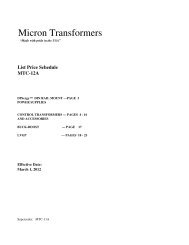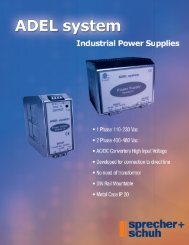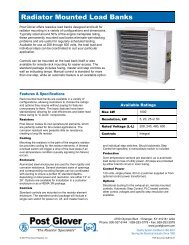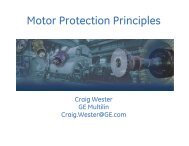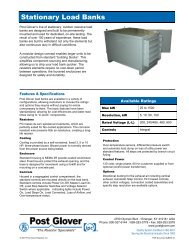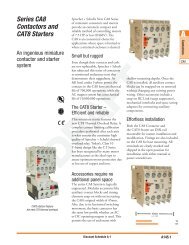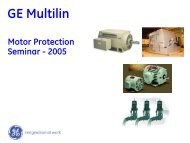Advantages and Disadvantages of Different Types of Neutral ...
Advantages and Disadvantages of Different Types of Neutral ...
Advantages and Disadvantages of Different Types of Neutral ...
You also want an ePaper? Increase the reach of your titles
YUMPU automatically turns print PDFs into web optimized ePapers that Google loves.
<strong>Advantages</strong> <strong>and</strong> <strong>Disadvantages</strong> <strong>of</strong><br />
<strong>Different</strong> <strong>Types</strong> <strong>of</strong> <strong>Neutral</strong> Grounding<br />
Systems<br />
Presented by<br />
John S. Levine, P.E.<br />
Levine Lectronics <strong>and</strong> Lectric, Inc.<br />
John@L-3.com<br />
www.L-3.com<br />
Post Glover Resistors, Inc.<br />
1
NEUTRAL GROUNDING OF POWER<br />
SYSTEMS<br />
OBJECTIVES<br />
1. Discuss five types <strong>of</strong> grounding for power<br />
systems.<br />
2. Discuss advantages <strong>of</strong> high resistance grounding.<br />
3. Show equipment<br />
2
POWER SYSTEM GROUNDING<br />
Power system grounding is a connection between an<br />
electrical circuit or equipment <strong>and</strong> the earth or to some<br />
conducting body that serves in place <strong>of</strong> earth.<br />
This presentation concerns the design <strong>of</strong> power system<br />
grounding for industrial <strong>and</strong> commercial facilities – not<br />
utility systems.<br />
3
DISCUSSION OF GROUNDING<br />
1. The ungrounded system<br />
2. The solidly grounded system<br />
3. Reactive grounding<br />
4. Low resistance grounding <strong>of</strong> power<br />
systems<br />
5. High resistance grounding <strong>of</strong> power<br />
systems<br />
4
Are You at Risk?<br />
Do you use<br />
electricity?<br />
Electrical deficiencies<br />
are the leading ignition<br />
source <strong>and</strong> cause <strong>of</strong><br />
fire <strong>and</strong> explosion.<br />
5
What is a Ground Fault?<br />
Contact between ground<br />
<strong>and</strong> an energized<br />
conductor<br />
Unleashes large amount<br />
<strong>of</strong> electrical energy<br />
Dangerous to<br />
equipment <strong>and</strong> people<br />
6
POWER SYSTEM GROUNDING<br />
SYSTEM FAILURES – SHORT CIRCUITS<br />
(FAULTS)<br />
INDUSTRIAL POWER SYSTEMS<br />
FAILURE MODE<br />
1. LINE TO GROUND<br />
2. PHASE - PHASE<br />
3. THREE PHASE<br />
PERCENTAGE<br />
OF FAILURES<br />
98 %<br />
Bolted Faults<br />
Two <strong>Types</strong> <strong>of</strong> Faults<br />
Solid connection between two phases<br />
or phase <strong>and</strong> ground resulting in high<br />
fault current.<br />
Stresses are well contained so fault<br />
creates less destruction.<br />
Arc Faults<br />
Usually caused by insulation<br />
breakdown, creating an arc between<br />
two phases or phase to ground.<br />
Intense energy is not well contained,<br />
<strong>and</strong> can be very destructive.<br />
8
Bolted Faults<br />
Result from a solid connection accidentally<br />
being made between two phases <strong>of</strong> the system<br />
or between one phase <strong>and</strong> an adjacent<br />
grounded metal surface.<br />
Because they are low resistance, high current<br />
events, this type <strong>of</strong> fault may actually be less<br />
destructive because the energy is spread over a<br />
large area <strong>and</strong> the protective devices are<br />
activated very rapidly by the large current.<br />
All types <strong>of</strong> electrical equipment with a<br />
withst<strong>and</strong> <strong>and</strong>/or interrupting rating are tested<br />
using bolted fault conditions.<br />
The majority <strong>of</strong> the stresses (thermal <strong>and</strong><br />
mechanical) are confined within the bus-bar<br />
<strong>and</strong> associated supports, so very little arc flash<br />
/ blast occurs, if any at all.<br />
9
600 Volt “THHN” Power Cable<br />
on “Ungrounded” System<br />
Arcing<br />
Fault<br />
10
Arc Fault<br />
Usually caused by insulation breakdown, an arc<br />
jumps between two phases or between one<br />
phase <strong>and</strong> a grounded metal surface.<br />
The resulting fault current is smaller because <strong>of</strong><br />
the relatively high resistance <strong>of</strong> the arc (25-<br />
40% <strong>of</strong> a bolted fault).<br />
Protective devices may be slow in responding to<br />
the smaller fault current.<br />
Arc faults can be the most destructive because <strong>of</strong><br />
the intense energy that is concentrated in the<br />
small area <strong>of</strong> the arc.<br />
The majority <strong>of</strong> the stresses (thermal <strong>and</strong><br />
mechanical) are not confined within the busbar<br />
<strong>and</strong> associated supports, it extends to the<br />
space in the compartment.<br />
11
THE ARCING FAULT<br />
An arcing fault is an intermittent failure between<br />
phases or phase to ground. It is a discontinuous<br />
current that alternately strikes, is extinguished <strong>and</strong><br />
restrikes again. For solidly grounded systems, the arc<br />
currents are: in percent <strong>of</strong> bolted three phase faulted<br />
FAULTS<br />
THREE PHASE 89%<br />
LINE-LINE 74%<br />
LINE-GROUND 38%<br />
12
Arcing Ground Faults<br />
Intermittent or Re-strike<br />
Intermittent ground fault: A re-striking ground fault can create a high frequency<br />
oscillator (RLC circuit), independent <strong>of</strong> L <strong>and</strong> C values, causing high transient overvoltages.<br />
– i.e. re-striking due to ac voltage waveform or loose wire caused by vibration<br />
480V Delta Source<br />
R fe<br />
3Ø Load<br />
V<br />
V<br />
C b<br />
C b<br />
Sfa<br />
13
Arcing Ground Faults<br />
Intermittent or Re-strike<br />
Plot <strong>of</strong> transient over-voltage for an arcing ground fault<br />
15
Industry Recommendations<br />
IEEE Std 242-2001 (Buff Book)<br />
Recommended Practice for Protection <strong>and</strong> Coordination <strong>of</strong> Industrial <strong>and</strong> Commercial<br />
Power Systems<br />
8.2.5 If this ground fault is intermittent or allowed to continue, the system could be<br />
subjected to possible severe over-voltages to ground, which can be as high as six to<br />
eight times phase voltage. Such over-voltages can puncture insulation <strong>and</strong> result in<br />
additional ground faults. These over-voltages are caused by repetitive charging <strong>of</strong> the<br />
system capacitance or by resonance between the system capacitance <strong>and</strong> the inductance<br />
<strong>of</strong> equipment in the system.<br />
16
THE UNGROUNDED POWER SYSTEM<br />
17
THE UNGROUNDEDED POWER SYSTEM<br />
18
UNGROUNDED SYSTEM<br />
NORMAL CONDITIONS<br />
19
UNGROUNDED SYSTEM<br />
NORMAL CONDITIONS<br />
20
UNGROUNDED SYSTEM<br />
GROUND FAULT ON PHASE A<br />
21
UNGROUNDED SYSTEM<br />
GROUND FAULT ON PHASE A<br />
22
THE UNGROUNDED POWER SYSTEM<br />
GROUND DETECTION CIRCUIT<br />
23
THE UNGROUNDED POWER SYSTEM<br />
GROUND DETECTION CIRCUIT<br />
24
THE UNGROUNDED POWER SYSTEM<br />
GROUND DETECTION CIRCUIT WITH ALARM<br />
25
THE UNGROUNDED POWER SYSTEM<br />
ADVANTAGES<br />
1. Low value <strong>of</strong> current flow for line to ground fault-<br />
5amps or less.<br />
2. No flash hazard to personnel for accidental line to<br />
ground fault.<br />
3. Continued operation on the occurrence <strong>of</strong> first line to<br />
ground fault.<br />
4. Probability <strong>of</strong> line to ground arcing fault escalating to<br />
line – line or three phase fault is very small.<br />
26
THE UNGROUNDED POWER SYSTEM<br />
DISADVANTAGES<br />
1. Difficult to locate line to ground fault.<br />
2. The ungrounded system does not control transient<br />
overvoltages.<br />
3. Cost <strong>of</strong> system maintenance is higher due to labor <strong>of</strong><br />
locating ground faults.<br />
4. A second ground fault on another phase will result in a<br />
phase-phase short circuit.<br />
27
THE SOLIDLY GROUNDED POWER<br />
SYSTEM<br />
28
THE SOLIDLY GROUNDED POWER SYSTEM<br />
29
SOLIDLY GROUNDED SYSTEM<br />
THREE PHASE SHORT CIRCUIT<br />
30
SOLIDLY GROUNDED SYSTEM<br />
THREE PHASE SHORT CIRCUIT<br />
31
SOLIDLY GROUNDED SYSTEM<br />
LINE – GROUND SHORT CIRCUIT<br />
32
SOLIDLY GROUNDED SYSTEM<br />
LINE – GROUND SHORT CIRCUIT<br />
33
SOLIDLY GROUNDED SYSTEM<br />
LINE-LINE SHORT CIRCUIT<br />
34
THE SOLIDLY GROUNDED POWER SYSTEM<br />
LINE TO GROUND FAULT<br />
35
Industry Recommendations<br />
IEEE Std 141-1993 (Red Book)<br />
Recommended Practice for Electric Power Distribution for Industrial Plants<br />
7.2.4 The solidly grounded system has the highest probability <strong>of</strong> escalating into a<br />
phase-to-phase or three-phase arcing fault, particularly for the 480V <strong>and</strong> 600V systems.<br />
The danger <strong>of</strong> sustained arcing for phase-to-ground fault probability is also high for the<br />
480V <strong>and</strong> 600V systems, <strong>and</strong> low for the 208V systems. For this reason ground fault<br />
protection is shall be required for system 1000A or more (NEC 230.95). A safety<br />
hazard exists for solidly grounded systems from the severe flash, arc burning, <strong>and</strong><br />
blast hazard from any phase-to-ground fault.<br />
36
THE SOLIDLY GROUNDED<br />
POWER SYSTEM<br />
ADVANTAGES<br />
1. Controls transient over voltage from neutral to ground.<br />
2. Not difficult to locate the fault.<br />
3. Can be used to supply line-neutral loads<br />
37
THE SOLIDLY GROUNDED<br />
POWER SYSTEM<br />
DISADVANTAGES<br />
1. Severe flash hazard<br />
2. Main breaker required<br />
3. Loss <strong>of</strong> production<br />
4. Equipment damage<br />
5. High values <strong>of</strong> fault current<br />
6. Single-phase fault escalation into 3 phase fault is likely<br />
7. Creates problems on the primary system<br />
38
NEUTRAL GROUNDING<br />
RESISTOR<br />
39
Reactive Grounding<br />
Uses reactor not resistor<br />
Fault values <strong>of</strong> transient-overvoltages are<br />
unacceptable in industrial environments<br />
Typically found in high voltage applications (>46<br />
kV)<br />
40
LOW RESISTANCE GROUNDING OF<br />
POWER SYSTEMS<br />
41
LOW RESISTANCE GROUNDING OF<br />
POWER SYSTEMS<br />
This design is generally for the following systems:<br />
• At 2.4 kv through 14,400 kv.<br />
• Systems serving motor loads<br />
• Current is limited to 200 to 400 amps<br />
• Systems typically designed to shut down in 10 seconds<br />
42
LOW RESISTANCE GROUNDED<br />
POWER SYSTEMS<br />
43
LOW RESISTANCE GROUNDED<br />
ZERO SEQUENCE RELAYING<br />
PARTIAL SINGLE LINE<br />
44
LOW RESISTANCE GROUNDED<br />
POWER SYSTEMS<br />
400 AMP GROUNDING<br />
<strong>Disadvantages</strong><br />
• Relatively large ground fault is required <strong>and</strong> thermal damge <strong>and</strong> core<br />
restacking is possible<br />
• The faulted machine is shutdown<br />
• Starter fuse may also operate<br />
• Must trip upstream circuit breaker.<br />
• Has been replaced by high resistance grounded systems with modern<br />
ct’s <strong>and</strong> relays.<br />
<strong>Advantages</strong><br />
• 400 amp grounding does look at a large part <strong>of</strong> the machine winding.<br />
45
HIGH RESISTANCE GROUNDING<br />
OF POWER SYSTEMS<br />
46
THE HIGH RESISTANCE<br />
GROUNDED<br />
POWER SYSTEM<br />
47
No Single Phase Loads<br />
No line-to-neutral loads allowed, prevents Hazards.<br />
480V Wye Source<br />
0V<br />
3Ø Load<br />
HRG<br />
AØ<br />
277V<br />
CØ<br />
N<br />
BØ<br />
277V<br />
480V<br />
480V<br />
0V<br />
Line-to-neutral Voltage is backfed via<br />
neutral wire, thus, not allowed.<br />
Ground ≈ AØ<br />
48
HIGH RESISTANCE GROUNDING<br />
AN EXAMPLE<br />
49
HIGH RESISTANCE GROUNDING –<br />
GROUND FAULT ON PHASE A<br />
50
HIGH RESISTANCE GROUNDING –<br />
GROUND FAULT ON PHASE A<br />
51
HIGH RESISTANCE GROUNDED SYSTEM<br />
LINE-GROUND SHORT CIRCUIT<br />
52
THE HIGH RESISTANCE GROUNDED<br />
POWER SYSTEM<br />
CONTROL OF TRANSIENT OVERVOLTAGE<br />
53
HIGH RESISTANCE GROUNDING<br />
54
THE HIGH RESISTANCE GROUNDED<br />
POWER SYSTEM<br />
LINE – GROUND FAULTS – DELTA CONNECTED MOTORS<br />
55
THE HIGH RESISTANCE GROUNDED<br />
POWER SYSTEM<br />
LINE-GROUND FAULTS WYE CONNECTED MOTORS<br />
56
HIGH RESISTANCE GROUNDING<br />
OF A 2400 VOLT SYSTEM<br />
57
THE HIGH RESISTANCE GROUNDED<br />
POWER SYSTEM<br />
CHOOSING THE GROUND RESISTOR<br />
Always specify a continuously rated resistor for 5 amps for all<br />
system voltages.<br />
SYSTEM<br />
VOLTAGE<br />
RESISTOR<br />
AMPS<br />
RESISTOR<br />
OHMS<br />
RESISTOR<br />
WATTS<br />
(CONTINUOUS)<br />
380 5 43.88 1,097<br />
415 5 47.92 1,198<br />
480 5 55.4 1,385<br />
600 5 69.3 1732<br />
2400 5 277 6,925<br />
3300 5 295 7,375<br />
4160 5 480 12,000<br />
58
THE HI-R GROUNDED POWER SYSTEM<br />
ADVANTAGES<br />
1. Low value <strong>of</strong> fault current<br />
2. No flash hazard<br />
3. Controls transient over voltage<br />
4. No equipment damage<br />
5. Service continuity<br />
6. No impact on primary system<br />
59
HOW DO YOU FIND<br />
GROUND FAULTS?<br />
Ungrounded<br />
Solidly grounded<br />
Low resistance grounded<br />
High resistance grounded<br />
60
HIGH RESISTANCE GROUNDING –<br />
GROUND FAULT ON PHASE A<br />
61
PROCEDURE FOR LOCATING<br />
GROUND FAULT<br />
1. Alarm indicates ground fault.<br />
2. Technician confirms ground<br />
faults by visiting substation.<br />
3. Voltage on meter relay<br />
4. Current through ground resistor.<br />
5. Substation zero sequence feeder<br />
ammeters will indicate specific feeder<br />
to MCC or Power Distribution Panel.<br />
6.Go to specific MCC or PDP, open<br />
wireway <strong>and</strong> use clamp-on ammeter<br />
around outgoing leads to determine<br />
failed circuit.<br />
7. Evaluate need to replace or fix<br />
component.<br />
62
Ground Fault Location Method<br />
NOTE: Tracking a ground fault can only be done on an energized<br />
system. Due to the inherent risk <strong>of</strong> electrocution this should<br />
only be performed by trained <strong>and</strong> competent personnel.<br />
63
Fault Location<br />
Method to quickly locate ground faults.<br />
Meter reading will alternate from<br />
5A to 10A every 2 seconds.<br />
480V Wye Source<br />
5A<br />
85A<br />
55A<br />
AØ<br />
BØ<br />
80A<br />
50A<br />
HRG<br />
55.4<br />
ohms<br />
5A<br />
CØ<br />
80A<br />
ZSCT<br />
30A 30A 30A<br />
0A<br />
50A<br />
55A<br />
ZSCT<br />
50A<br />
50A<br />
5A<br />
Meter<br />
Meter<br />
5A<br />
ZSCT<br />
0A<br />
30A<br />
30A<br />
30A<br />
50A 50A 50A<br />
Meter<br />
Motor<br />
Motor<br />
64
Per IEEE…<br />
TO HRG OR NOT TO HRG?<br />
IEEE Std 142-1991 (Green Book)<br />
Recommended Practice for Grounding <strong>of</strong> Industrial <strong>and</strong> Commercial<br />
Power Systems<br />
1.4.3 The reasons for limiting the current by resistance<br />
grounding may be one or more <strong>of</strong> the following.<br />
1) To reduce burning <strong>and</strong> melting effects in faulted electric<br />
equipment, such as switchgear, transformers, cables, <strong>and</strong><br />
rotating machines.<br />
2) To reduce mechanical stresses in circuits <strong>and</strong> apparatus<br />
carrying fault currents.<br />
3) To reduce electric-shock hazards to personnel caused<br />
by stray ground-fault currents in the ground return path.<br />
65
Per IEEE…<br />
TO HRG OR NOT TO HRG?<br />
IEEE Std 142-1991 (Green Book)<br />
Recommended Practice for Grounding <strong>of</strong> Industrial <strong>and</strong> Commercial<br />
Power Systems<br />
1.4.3 The reasons for limiting the current by resistance<br />
grounding may be one or more <strong>of</strong> the following.<br />
4) To reduce the arc blast or flash hazard to personnel who<br />
may have accidentally caused or who happen to be in close<br />
proximity to the ground fault.<br />
5) To reduce the momentary line-voltage dip occasioned by<br />
the clearing <strong>of</strong> a ground fault.<br />
6) To secure control <strong>of</strong> transient over-voltages while at the<br />
same time avoiding the shutdown <strong>of</strong> a faulty circuit on<br />
the occurrence <strong>of</strong> the first ground fault (high resistance<br />
grounding).<br />
66
Per IEEE…<br />
TO HRG OR NOT TO HRG?<br />
IEEE Std 141-1993 (Red Book)<br />
Recommended Practice for Electric Power Distribution for Industrial<br />
Plants<br />
7.2.2 There is no arc flash hazard, as there is with solidly<br />
grounded systems, since the fault current is limited to<br />
approximately 5A.<br />
Another benefit <strong>of</strong> high-resistance grounded systems is<br />
the limitation <strong>of</strong> ground fault current to prevent damage<br />
to equipment. High values <strong>of</strong> ground faults on solidly<br />
grounded systems can destroy the magnetic core <strong>of</strong> rotating<br />
machinery.<br />
67
Per IEEE…<br />
TO HRG OR NOT TO HRG?<br />
IEEE Std 242-2001 (Buff Book)<br />
Recommended Practice for Electric Power Distribution for Industrial<br />
Plants<br />
8.2.5 Once the system is high-resistance grounded, overvoltages<br />
are reduced; <strong>and</strong> modern, highly sensitive<br />
ground-fault protective equipment can identify the<br />
faulted feeder on the first fault <strong>and</strong> open one or both<br />
feeders on the second fault before arcing burn down<br />
does serious damage.<br />
68
Design Considerations with<br />
HRG Systems<br />
National Electrical Code (2005)<br />
250.36 High-impedance grounded neutral systems in which a<br />
grounding impedance, usually a resistor, limits the<br />
ground-fault current to a low value shall be permitted for<br />
3-phase ac systems <strong>of</strong> 480 volts to 1000 volts where all the<br />
following conditions are met:<br />
1) The conditions <strong>of</strong> maintenance <strong>and</strong> supervision<br />
ensure that only qualified persons service the<br />
installation.<br />
2) Continuity <strong>of</strong> power is required.<br />
3) Ground detectors are installed on the system.<br />
4) Line-to-neutral loads are not served.<br />
69
Duty Ratings for NGR’s<br />
IEEE Std 32<br />
Time Rating <strong>and</strong> Permissible Temperature Rise for <strong>Neutral</strong> Grounding<br />
Resistors<br />
Time Rating (On Time)<br />
Ten Seconds (Short Time)<br />
One Minute (Short Time)<br />
Ten Minutes (Short Time)<br />
Extended Time<br />
Continuous<br />
Temp Rise (deg C)<br />
760 o C<br />
760 o C<br />
610 o C<br />
610 o C<br />
385 o C<br />
Increased Fault Time Requires Larger Resistor<br />
Duration Must Be Coordinated With Protective Relay Scheme<br />
70
COMPARISON OF THE FOUR<br />
METHODS<br />
71
HIGH RESISTANCE GROUNDING<br />
OF A 2400 VOLT MOTOR SYSTEM<br />
COMPARISON OF SOME CHARACTERISTICS<br />
72
THE HIGH RESISTANCE GROUNDED<br />
POWER SYSTEM<br />
DAMAGE TO POWER SYSTEM COMPONENTS<br />
1. Thermal damage<br />
2. Mechanical damage<br />
( I RMS )2<br />
t<br />
( I p )2<br />
Comparison <strong>of</strong> solidly grounded <strong>and</strong> high resistance grounding<br />
methods – 2000 KVA transformer at 480 volts<br />
SYSTEM<br />
GROUNDING<br />
LINE-GROUND<br />
FAULT AMPS<br />
DAMAGE TO<br />
EQUIPMENT<br />
Hi – R 5 A 1 per unit<br />
Solidly 20,000 A 16 x 10 6<br />
(<br />
20,000 A<br />
)<br />
2<br />
Increase in damage = = 16,000,000<br />
5 A<br />
73
THE HIGH RESISTANCE GROUNDING<br />
OF POWER SYSTEM<br />
The high resistance grounded power system is the “the<br />
best”. This system provides the following advantages:<br />
1. No shutdowns when a ground fault occurs<br />
2. Quick identification <strong>of</strong> the problem<br />
3. Safer for personnel & equipment<br />
4. Offers all <strong>of</strong> advantages <strong>of</strong> the ungrounded & solidly<br />
grounded systems<br />
5. No known disadvantages<br />
74
Retr<strong>of</strong>it from Solidly or<br />
Ungrounded Grounded System<br />
to High Resistance Design<br />
Considerations<br />
1. Are cables rated line to line or line to neutral. On a<br />
480 Volt system some people have installed 300 Volt<br />
cable.<br />
2. Are there surge arrestors <strong>and</strong> MOV’s on the system.<br />
Are they sufficiently rated?<br />
3. Are the <strong>Neutral</strong>s on the transformers fully insulated?<br />
4. Are there other sources <strong>of</strong> power on the circuit?<br />
Generators or Tie Breakers<br />
75
Resolve NEC requirement<br />
Add small 1:1<br />
transformer <strong>and</strong> solidly<br />
ground secondary for 1Φ<br />
loads (i.e. lighting).<br />
76
High Resistance Grounding<br />
What if no neutral exists (i.e. delta systems)?<br />
– A grounding transformer is installed (either a zig-zag or a wye-delta)<br />
from all three phases to create an artificial neutral for grounding<br />
purposes only.<br />
AØ BØ CØ<br />
AØ BØ CØ<br />
AØ BØ CØ<br />
Zig-Zag<br />
Grounding<br />
Transformer<br />
HRG<br />
HRG<br />
HRG<br />
Wye-Delta<br />
Grounding<br />
Transformers<br />
Broken Delta<br />
Grounding<br />
Transformers<br />
77
Minimum Specifications<br />
120 Volt Control Circuit<br />
385ºC Temperature Rise Resistor<br />
Line Disconnect Switch<br />
Ground Bus (freest<strong>and</strong>ing units only)<br />
Pulser, Including Pulsing Contractor, Pulsing Timer, Normal/Pulse Selector Switch<br />
Relays for under <strong>and</strong> over voltage<br />
Relays for under <strong>and</strong> over current measuring only fundamental<br />
Auxiliary contacts<br />
Test Push-button<br />
Fault Reset Push-button<br />
Green Indicating Light for “Normal” Indication<br />
Red Indicating Light for “Fault” Indication<br />
78
CHARGING CURRENT<br />
CALULATIONS<br />
Slides hidden due to time allowed for<br />
Presentation<br />
79
HIGH RESISTANCE GROUNDING – 2.4KV SYSTEM<br />
CALCULATION OF SYSTEM CHARGING CURRENT<br />
80
CHARGING CURRENT TESTS<br />
ON POWER SYSTEMS<br />
Tests made by federal pioneer <strong>of</strong> Canada at several pulp <strong>and</strong><br />
paper sites in Canada.<br />
.02-.06 amps per 1000kva <strong>of</strong> transformer nameplate KVA.<br />
For system with no aerial construction.<br />
TRANSFORMER<br />
CHARGING<br />
KVA<br />
CURRENT<br />
1000 .02 - .06 AMPS<br />
1500 .03 - .09 AMPS<br />
2000 .04 – .12 AMPS<br />
2500 .05 – .15 AMPS<br />
81
HIGH RESISTANCE GROUNDING 2.4KV SYSTEM<br />
CALCULATION OF CHARGING CURRENTS<br />
1. SURGE CAPACITORS<br />
6<br />
3 ICO = 3(2πf CE/10 ) = 3(2π*60*.5X(2400V/3^1/2)= 3X.261= .783 AMPS<br />
10 6<br />
2. MOTORS<br />
HP<br />
3 ICO = [0.005X ( )] REF. ALVIN KNABLE<br />
RPM<br />
450<br />
1765<br />
200<br />
180<br />
100<br />
257<br />
125<br />
585<br />
450 HP MOTOR 0.05 X = .013AMPS<br />
200 HP MOTOR 0.05 X = .06AMPS<br />
100 HP MOTOR 0.05 X = .02AMPS<br />
125 HP MOTOR 0.05 X = .01AMPS<br />
3. ZIG-ZAG TRANSFORMER – APPROXIMATE VALUE .01 TO .001 MICRO FARAD<br />
__10^6 __<br />
XC= = 2.65 X 10^5 TO 2.65 X 10^6 OHMS<br />
377X10^-2<br />
3ICO= = .0156 TO .00156 AMPS. DISREGARD THIS VALUE<br />
2400/3^(1/2)<br />
2.65X10^5<br />
82
HIGH RESISTANCE GROUNDING 2.4KV SYSTEM<br />
CALCULATION OF SYSTEM CHARGING CURRENT<br />
4. CABLE CAPACITANCE<br />
C=<br />
0.00735(SIC) _mfd_<br />
WHERE SIG= SPECIFIC INDUCTIVE CAPACITANCE =3<br />
LOG (D/d) 100 ft.<br />
D= DIAMETER OVER INSULATION<br />
d=DIAMETER OF CONDUCTOR<br />
AVERAGE LENGTH OF CABLE RUNS = 75 FT, #2 5KV UNSHIELDED.<br />
C= _0.00735*3_<br />
LOG (.56.34)<br />
_75 f_<br />
1000 ft<br />
_____10^6_____<br />
377 X 7.63x10^-3<br />
C= .1017 X = 7.63X10^-3 ufd<br />
Xc= =3.47x10^5 OHMS.<br />
3Ico= = .0119AMPS = .012AMPS PER FEEDER<br />
__2400/ 3^(1/2)__<br />
3.47X10^5 OHMS<br />
83
HIGH RESISTANCE GROUNDING – 2.4KV SYSTEM<br />
CALCULATION OF SYSTEM CHARGING CURRENT<br />
84
HIGH RESISTANCE GROUNDING 2.4KV SYSTEM<br />
CALCULATION OF SYSTEM CHARGING CURRENT<br />
SUMMARY OF CAPACITIVE FAULT CURRENT VALUES<br />
3MVA Transformer = .15A.<br />
FDR#1 = .013 + .012 = .025A.<br />
#2 = .06 + .012 =.072A.<br />
#3 =.06 + .012 =.072A<br />
#4 =.02 + .012 =.032A<br />
#5 =.02 + .012 =.032A<br />
#6 =.01 + .012 =.022A<br />
SURGE CAPACITORS = .783A<br />
1.188 AMPS<br />
CHOSE GROUNDING RESISTOR OF 5 AMPS<br />
NOTE: SURGE CAPACITORS ACCOUNT FOR 75% OF THE TOTAL<br />
85
GENERATOR APPLICATONS<br />
OF NEUTRAL GROUNDING<br />
RESISTORS<br />
86
GENERATOR APPLICATONS<br />
OF NEUTRAL GROUNDING<br />
RESISTORS<br />
1. All generators should use a NGR.<br />
2. If you have 2 generators on a system with<br />
different pitches you will need to use 2 NGRs to<br />
limit the harmonics that are generated.<br />
3. On a delta generator you should use an NGR<br />
with a zig-zag transformer.<br />
88
Generator Grounding – IEEE<br />
IEEE Std 242-2001 (Buff Book)<br />
12.4 Generator Grounding<br />
• A common practice is to ground all types <strong>of</strong> generators through some form<br />
<strong>of</strong> external impedance. The purpose <strong>of</strong> this grounding is to limit the<br />
mechanical stresses <strong>and</strong> fault damage in the machine, to limit transient voltages<br />
during fault, <strong>and</strong> to provide a means for detecting ground faults within the<br />
machine…<br />
Solid grounding <strong>of</strong> a generator neutral is not generally used because this<br />
practice can result in high mechanical stresses <strong>and</strong> excessive fault damage in<br />
the machine…<br />
Generators are not <strong>of</strong>ten operated ungrounded. While this approach greatly<br />
limits damage to the machine, it can produce high transient overvoltages during<br />
faults <strong>and</strong> also makes it difficult to locate the fault.<br />
89
Generator Grounding – IEEE<br />
IEEE Std. 142-1991 (Green Book)<br />
1.8.1 Discussion <strong>of</strong> Generator Characteristics<br />
• …Unlike the transformer, the three sequence reactances <strong>of</strong> a generator are not equal.<br />
The zero-sequence reactance has the lowest value, <strong>and</strong> the positive sequence<br />
reactance varies as a function <strong>of</strong> time. Thus, a generator will usually have higher<br />
initial ground-fault current than a three-phase fault current if the generator is<br />
solidly grounded. According to NEMA, the generator is required to withst<strong>and</strong><br />
only the three-phase current level unless it is otherwise specified…<br />
A generator can develop a significant third-harmonic voltage when loaded. A<br />
solidly grounded neutral <strong>and</strong> lack <strong>of</strong> external impedance to third harmonic current will<br />
allow flow <strong>of</strong> this third-harmonic current, whose value may approach rated current. If<br />
the winding is designed with a two-thirds pitch, this third-harmonic voltage will be<br />
suppressed but zero-sequence impedance will be lowered, increasing the ground-fault<br />
current…<br />
Internal ground faults in solidly grounded generators can produce large fault<br />
currents. These currents can damage the laminated core, adding significantly to the<br />
time <strong>and</strong> cost <strong>of</strong> repair…Both magnitude <strong>and</strong> duration <strong>of</strong> these currents should be<br />
limited whenever possible.<br />
90
AIC Rating<br />
(Amps Interrupting Current)<br />
This example is taken from lowzero.pdf by Power Systems<br />
Engineering<br />
– 3 Phase Short Circuit Calculations for the Generator is 11.1 kA<br />
– Line to Ground Fault Current for the Generator is 13.8 kA because<br />
the zero sequence impedance (X0) is lower than the positive<br />
sequence impedance (X1)<br />
Line to Ground Fault Current is 125% <strong>of</strong> the Phase Current<br />
Fault in this example<br />
Solution – Make sure you check your AIC rating <strong>of</strong> the<br />
equipment <strong>and</strong> use a <strong>Neutral</strong> Grounding Resistor.<br />
91
GENERATOR APPLICATONS<br />
OF NEUTRAL GROUNDING<br />
RESISTORS<br />
A large generator (> 20 MVA, 13,800 volt)<br />
may take 5 to 20 seconds to stop. A IEEE<br />
working group wrote a series <strong>of</strong> four papers.<br />
They proposed a hybrid system having a<br />
low resistance grounding system <strong>and</strong> when<br />
the fault occurred switch to a high<br />
resistance grounded system.<br />
92
HYBRID SYSTEM<br />
93
Pictures <strong>of</strong> Equipment<br />
94
Common options<br />
Enclosure rating<br />
Enclosure finish<br />
Current transformer<br />
Potential transformer<br />
Disconnect switch<br />
Entrance/exit bushings<br />
Elevating st<strong>and</strong><br />
Seismic rating<br />
Hazardous area classification<br />
Third party certification<br />
95
100
101
This presentation can be found at:<br />
http://www.l-3.com/private/ieee/<br />
post_glover_resistance_grounding_2010.pdf<br />
102
103
Thank You<br />
Questions?<br />
104



